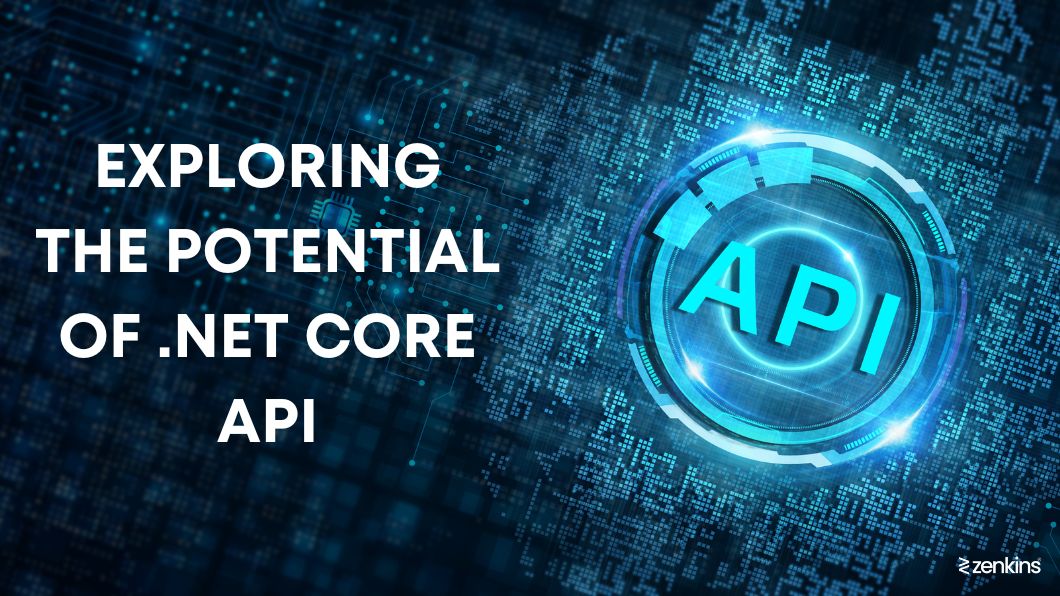Exploring the Potential of .NET Core API
Table of Contents
The .NET Core API is a powerful framework that allows developers to build robust and scalable web APIs. With its platform independence and open-source nature, .NET Core API has gained popularity among developers worldwide. In this article, we will explore the potential of .NET Core API and delve into its key features, architectural components, and benefits. We will also discuss best practices for building secure and performant APIs, as well as integrating third-party services. Additionally, we will look into future possibilities and advancements in .NET Core API development, providing insights into the exciting future of this technology.
Introduction to .NET Core API
What is .NET Core API?
Ever wondered how the internet works? How various websites, apps, and services communicate with each other? Well, it is all made possible through the magic of APIs! API stands for Application Programming Interface, and it acts as a bridge between different software systems, enabling them to interact and exchange data.
.NET Core API, developed by Microsoft, is a powerful framework that allows you to build robust and scalable APIs. It provides a set of libraries, tools, and runtime components that simplify the process of building and deploying APIs. Whether you are building a web application, mobile app, or desktop software, .NET Core API has got you covered.
Key Features of .NET Core API
So, what makes .NET Core API stand out from the crowd? Let’s take a look at some of its key features:
– Cross-platform compatibility: With .NET Core API, you can build and deploy your APIs on Windows, macOS, and Linux, giving you the freedom to choose your development environment.
– High performance: .NET Core API is designed to be fast and efficient, ensuring that your APIs can handle a large number of requests without breaking a sweat.
– Open-source and community-driven: .NET Core API is open-source, meaning that its source code is freely available for everyone to view, modify, and contribute to. This fosters a vibrant community of developers who constantly improve and enhance the framework.
Now that we have a basic understanding of .NET Core API, let’s dive deeper into the benefits it offers.
Understanding the Benefits of .NET Core
Improved Performance and Scalability
In the fast-paced world of software development, performance is paramount. .NET Core API is built with performance in mind, employing various optimizations and enhancements to ensure lightning-fast response times. It utilizes just-in-time (JIT) compilation, which dynamically compiles your code at runtime, resulting in efficient execution.
Furthermore, .NET Core API allows for the horizontal scaling of your APIs. This means that as your user base grows, you can easily add more servers to handle the increased workload. This scalability ensures that your APIs remain responsive and available even under heavy traffic.
Platform Independence
Are you tired of being tied down to a specific operating system? Well, with .NET Core API, you can break free! Thanks to its cross-platform nature, you can develop and deploy your APIs on Windows, macOS, and Linux. This flexibility not only saves you time and resources but also opens up a world of possibilities for your applications.
Open-source and Community-driven
.NET Core API is an open-source framework, which means it is constantly evolving and improving with the help of a vibrant community of developers. This community-driven approach ensures that new features are added, bugs are fixed, and overall enhancements are made on a regular basis. By harnessing the collective knowledge and expertise of the community, you can benefit from the collective wisdom of thousands of developers worldwide.
Now that you understand the benefits of .NET Core, let’s delve into its architecture and explore how it all comes together.
Exploring the Architecture of .NET Core API
Overview of the MVC Pattern
At the heart of .NET Core API lies the Model-View-Controller (MVC) pattern. This architectural pattern separates the concerns of data, presentation, and control, making your code more modular and maintainable. The model represents your data, the view handles the presentation of that data, and the controller manages the interaction between the two.
Understanding Middleware in .NET Core
Middleware is like the middleman in the journey of a request through your API. It sits between the incoming request and the final response, allowing you to perform various operations such as authentication, logging, error handling, and more. The beauty of middleware is that you can chain multiple middleware components together to build a pipeline that processes requests in a specific order.
Dependency Injection in .NET Core API
Dependency injection is a design pattern that promotes loose coupling and modularity in your code. It allows you to inject dependencies into your classes rather than creating them within the class itself. This makes your code more flexible, testable, and maintainable. .NET Core API provides a built-in dependency injection container that takes care of resolving and injecting dependencies for you.
Read about How to Migrate from .NET Framework to .NET Core
Building Robust and Scalable APIs with .NET Core
Designing RESTful APIs with .NET Core
RESTful APIs have become the de facto standard for building web services. With .NET Core API, designing RESTful APIs is a breeze. It provides a rich set of features for handling HTTP requests and responses, including attribute routing, content negotiation, input validation, and more. By following best practices and leveraging the power of .NET Core API, you can create APIs that are intuitive, efficient, and well-documented.
Error Handling and Exception Management
Nobody likes errors, but they are an inevitable part of software development. With .NET Core API, you can handle errors and exceptions gracefully. It provides a robust error handling pipeline that allows you to centralize your error handling logic, customize error responses, and log errors for further analysis. By properly managing errors, you can enhance the user experience and ensure that your APIs continue to run smoothly even in the face of adversity.
Implementing Caching for Performance Optimization
Caching can be a game-changer when it comes to performance optimization. .NET Core API offers various mechanisms for implementing caching, including in-memory caching, distributed caching, and response caching. By strategically caching data and responses, you can reduce the load on your APIs, improve response times, and provide a better user experience. With .NET Core API, caching has never been easier.
Leveraging .NET Core Features for Enhanced Performance
Asynchronous Programming with async/await
You know that feeling when you’re waiting for a slow-loading webpage to finally display its contents? Yeah, we’ve all been there. But fear not, because .NET Core has got your back with its asynchronous programming capabilities. By using the async/await keywords, you can write code that doesn’t block the main thread, resulting in a more responsive and performant application. Say goodbye to those frustrating loading screens!
Optimizing Database Access with Entity Framework Core
Let’s talk about databases. They’re like the backbone of any application, holding all those precious data nuggets. With Entity Framework Core, you can easily interact with your database without getting tangled up in complex SQL queries. It provides a convenient and intuitive way to perform CRUD operations, making your life as a developer a whole lot smoother. Plus, it automatically optimizes the database access for you, so you can focus on the important stuff, like deciding where to order lunch from.
Using Caching Techniques for Performance Boost
Caching is like having a super-speedy memory bank for your application. It saves frequently accessed data so that your application doesn’t need to fetch it from the original source every single time. .NET Core API makes it a breeze to implement caching techniques, allowing you to drastically improve the performance of your application. So, go ahead and cache that data, and watch your app zip along like a cheetah on rollerblades.
Security Best Practices for .NET Core API Development
Implementing Authentication and Authorization
You wouldn’t invite just anyone to your private backyard barbecue, right? The same principle applies to your API. With .NET Core, you can easily implement authentication and authorization to restrict access only to the allowed parties. Whether it’s basic authentication, token-based authentication, or even implementing your custom authentication scheme, .NET Core has got the tools to keep your API secure, so you can sleep peacefully knowing that your data is protected.
Securing API Endpoints with JWT Tokens
Ah, JWT tokens, the guardians of API security. With .NET Core, you can leverage the power of JSON Web Tokens to secure your API endpoints. These tokens act as digital passports, containing information about the user and their permissions. By validating these tokens, you can ensure that only authorized requests are allowed access to your precious API resources. It’s like having a bouncer at the entrance of your VIP club, but way less intimidating.
Protecting Against Common Security Threats
Nobody likes surprises, especially when it comes to security breaches. That’s why .NET Core provides you with the necessary tools to protect your API against common security threats. Cross-site scripting (XSS), cross-site request forgery (CSRF), and SQL injection are just a few examples of the sneaky dangers that can be mitigated with .NET Core’s security features. So go ahead, sleep with both eyes closed, because your API is safe and sound.
Integrating Third-Party Services with .NET Core API
Working with External APIs and Web Services
Sometimes, building an application means using resources from other services. .NET Core makes it a breeze to integrate with external APIs and web services. Whether you need to fetch weather data, process payments, or even connect to social media platforms, .NET Core has your back. With its extensive library support and intuitive integration capabilities, you can seamlessly incorporate third-party services into your application and take it to the next level.
Using NuGet Packages for Easy Integration
Ah, NuGet packages, the magical treasure trove of pre-built code snippets. With .NET Core, you can easily add NuGet packages to your application to leverage existing functionality and save yourself from reinventing the wheel. Whether it’s integrating with a payment gateway, adding logging capabilities, or even incorporating AI features, chances are there’s a NuGet package for that. So save time and effort by tapping into the vast ecosystem of NuGet packages and turbocharge your development.
Implementing Webhooks and Event-driven Architecture
Sometimes, you want your application to react to events happening outside of its own realm. That’s where webhooks and event-driven architecture come into play. With .NET Core, you can effortlessly set up webhooks to receive notifications and trigger specific actions in your application. This allows you to create dynamic and reactive systems that respond to external events in real-time. So sit back, relax, and let the events come to you, because your application is ready to dance to the webhook tune.
Future Possibilities and Advancements in .NET Core API Development
Upcoming Features in .NET Core
.NET Core is an ever-evolving platform, constantly adding new features to make your life as a developer even more exciting. With each new version, you can expect improvements in performance, new tools and libraries, and enhanced developer experience. So keep your eyes peeled for those upcoming features because the future of .NET Core API development is looking bright.
Exploring Microservices Architecture with .NET Core
Microservices, the cool kids on the architectural block. With .NET Core, you can dive into the world of microservices and build scalable and maintainable applications. By breaking your application into smaller, loosely coupled services, you can achieve better separation of concerns and distribute the workload more efficiently. .NET Core provides the necessary tools and frameworks to embrace the microservices paradigm, so you can wave goodbye to monolithic headaches and say hello to a more flexible and agile development process.
Building Cloud-Native Applications with .NET Core
The cloud, where dreams of scalability and flexibility come true. With .NET Core, you can build cloud-native applications that are designed to harness the power of the cloud. Whether it’s leveraging containerization with Kubernetes, using Azure services for seamless integration, or adopting serverless architectures, .NET Core has got you covered. So pack your bags and embark on a journey to cloud-native bliss, because the sky’s the limit with .NET Core.
In conclusion, the .NET Core API offers developers a versatile and efficient framework for building powerful web APIs. With its numerous benefits, such as improved performance, platform independence, and a vibrant community, .NET Core API is shaping the future of API development. By implementing best practices, leveraging its features, and exploring integrations with third-party services, developers can unlock the full potential of .NET Core API. With continuous advancements and future possibilities on the horizon, the journey of building tomorrow with .NET Core API is an exciting one.
FAQ
What is the difference between .NET Core API and .NET Framework?
The main difference between .NET Core API and .NET Framework lies in their scope and platform compatibility. While .NET Framework is primarily designed for Windows applications, .NET Core API is cross-platform, allowing developers to build applications that can run on Windows, macOS, and Linux. .NET Core API also offers improved performance, scalability, and a smaller footprint compared to .NET Framework.
Can I migrate my existing .NET Framework API to .NET Core?
Yes, it is possible to migrate your existing .NET Framework API to .NET Core. Although the process may require some modifications and updates to your codebase, Microsoft provides tools and guidance to facilitate the migration process. By migrating to .NET Core API, you can take advantage of its benefits, such as improved performance, platform independence, and the latest features.
Is .NET Core API suitable for building large-scale enterprise applications?
Absolutely! .NET Core API is well-suited for building large-scale enterprise applications. Its performance enhancements, scalability features, and support for modern architectural patterns like microservices make it an excellent choice for handling complex business requirements. Additionally, its ecosystem of libraries, frameworks, and tooling provides robust support for enterprise application development.
Can I deploy .NET Core API to the cloud?
Yes, .NET Core API can be easily deployed to the cloud. With its platform independence, you can deploy your API to popular cloud platforms such as Azure, AWS, or Google Cloud Platform. Leveraging cloud services and infrastructure, you can achieve scalability, high availability, and global reach for your API, ensuring optimal performance and cost efficiency.




